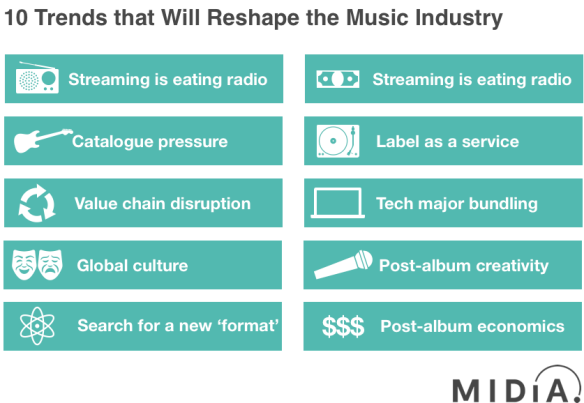The IFPI has reported that global recorded music revenues have hit $19.1 billion, which means that MIDiA’s own estimates published in March were within 1.6% of the actual results. This revenue growth story is strong and sustained but the market itself is undergoing dramatic change. Here are 10 trends that will reshape the recorded music business over the coming years:

- Streaming is eating radio: Younger audiences are abandoning radio for streaming. Just 39% of 16-19-year olds listen to music radio, while 56% use YouTube instead for music. Gen Z is unlikely to ever ‘grow into radio’; if you are trying to break an artist with a young audience, it is no longer your best friend. To make matters worse, podcasts are looking like a Netflix moment for radio and may start stealing older audiences. This is essentially a demographic pincer movement.
- Streaming deflation: Streaming music has allowed itself to be outpaced by inflation. A $9.99 subscription from 2009 is actually $13.36 when inflation is factored in. Contrast this with Netflix, for which theinflation-adjusted price is $10.34 but the actual 2019 price is $12.99. Netflix has stayed ahead of inflation; Spotify and co. have fallen behind. It is easier for Netflix to increase prices as it has exclusive content, but rights holders and streaming services need to figure out a way to bring prices closer to inflation. A market-wide increase to $10.99 would be a sound start, and the fact that so many Spotify subscribers are willing to pay $13 a month via iTunes shows there is pricing tolerance in the market.
- Catalogue pressure: Deep catalogue has been the investment fund of labels for years. But with most catalogue streams coming from music made in this century, catalogue values are being turned upside down (in the streaming era, the Spice Girls are worth more than the Beatles!). Labels can still extract high revenue from legacy artists with super premium editions like UMG did with the Beatles in 2018, but a new long-term approach is required for valuing catalogue. Matters are complicated further by the fact that labels are now doing so many label services deals, and therefore not building future catalogue value.
- Labels as a service (LAAS): Artists can now create their own virtual label from a vast selection of services such as 23 Capital, Amuse, Splice, Instrumental, and CDBaby. A logical next step is for a 3rdparty to aggregate a selection of these services into a single platform (an opening for Spotify?). Labels need to get ahead of this trend by better communicating the soft skills and assets they bring to the equation, e.g. dedicated personnel, mentoring, and artist and repertoire (A+R) support.
- Value chain disruption: LAAS is just part of a wider trend of value chain disruption with multiple stakeholders trying to expand their roles, from streaming services signing artists to labels launching streaming services. Things are only going to get messier, with virtually everyone becoming a frenemy of the other.
- Tech major bundling: Amazon set the ball rolling with its Prime bundle, and Apple will likely follow suit with its own take on the tech major bundle. Music is going to become just one part of content offerings from tech majors and it will need to fight for supremacy, especially in the ultra-competitive world of the attention economy.
- Global culture: Streaming – YouTube especially – propelled Latin music onto the global stage and soon we may see Spotify and T-Series combining to propel Indian music into a similar position. The standard response by Western labels has been to slap their artists onto collaborations with Latin artists. The bigger issue to understand, however, is that something that looks like a global trend may not be a global trend at all but is simply reflecting the size of a regional fanbase. The old music business saw English-speaking artists as the global superstars. The future will see global fandom fragmented with much more regional diversity. The rise of indigenous rap scenes in Germany, France and the Netherlands illustrates that streaming enables local cultural movements to steal local mainstream success away from global artist brands.
- Post-album creativity: Half a decade ago most new artists still wanted to make albums. Now, new streaming-era artists increasingly do not want to be constrained by the album format, but instead want to release steady streams of tracks in order to keep their fan bases engaged. The album is still important for established artists but will diminish in importance for the next generation of musicians.
- Post-album economics: Labels will have to accelerate their shift to post-album economics, figuring out how to drive margin with more fragmented revenue despite having to invest similar amounts of money into marketing and building artist profiles.
- The search for another format: In 1999 the recorded music business was booming, relying on a long established, successful format that did not have a successor. 20 years on, we are in a similar place with streaming. The days of true format shifts are gone due to the fact we don’t have dedicated format-specific music hardware anymore. However, the case for new commercial models and user experiences is clear. Outside of China, depressingly little has changed in terms of digital music experiences over the last decade. Even playlist innovation has stalled. One potential direction is social music. Streaming has monetized consumption; now we need to monetize fandom.

No comments:
Post a Comment